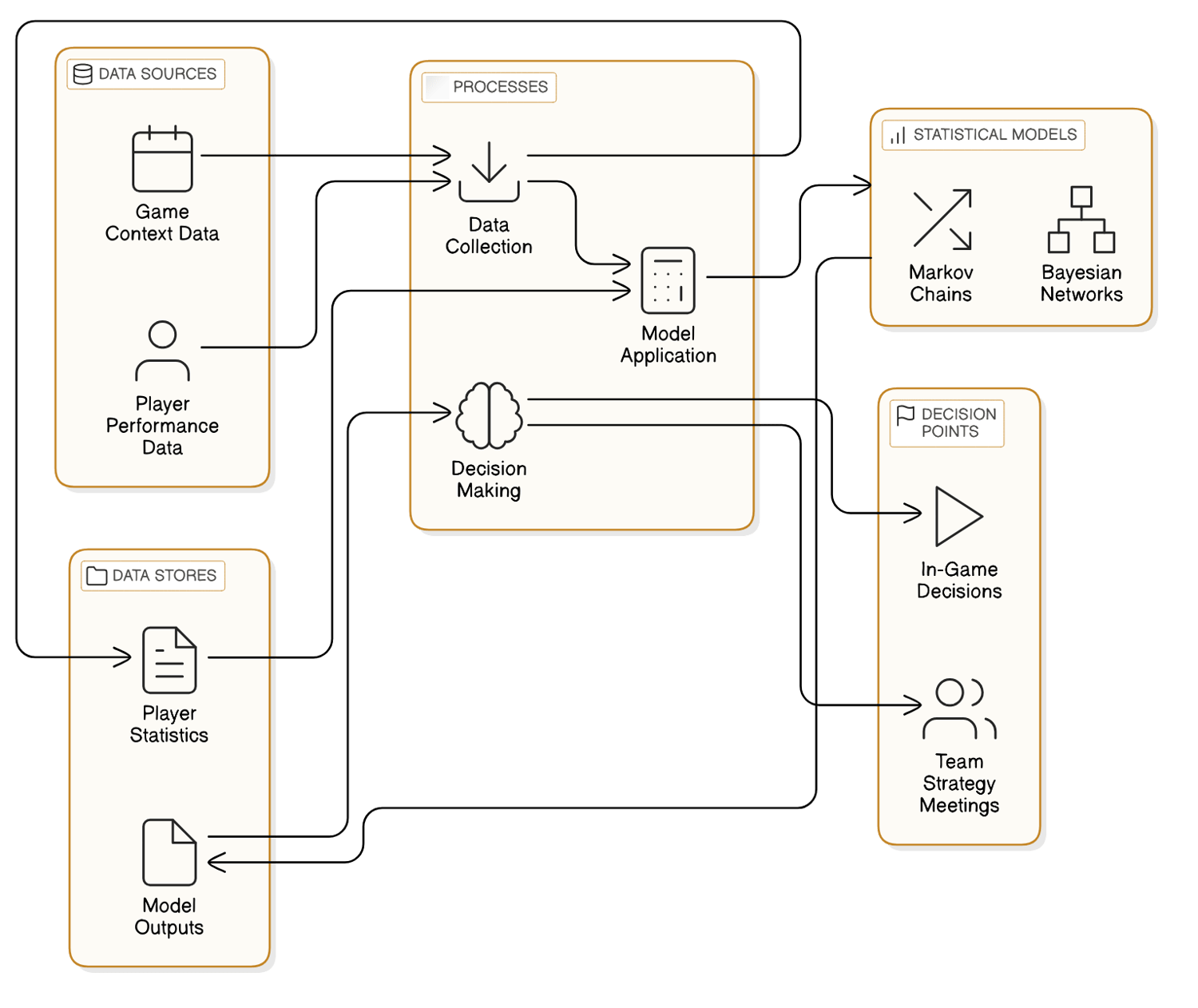Summary
This article delves into the fascinating world of advanced baseball statistics, showcasing how data science is revolutionizing player evaluation and performance analysis. It highlights the importance of embracing these innovative approaches for a richer understanding of the game. Key Points:
- The integration of diverse data sources with machine learning enhances player performance predictions and personalized training regimens.
- Research into non-linear relationships provides deeper insights into offensive and defensive contributions, moving beyond traditional linear models.
- Advancements in defensive metrics, including computer vision and player positioning simulations, offer a more granular evaluation of fielding impacts.
Unlocking the Secrets of Baseball: Why Advanced Statistics Matter?
My First Foray into Baseball Analytics: A Story of Frustration and Discovery
“Seriously,” I said to my friend Mike as we sat in the local coffee shop, “why does it feel like I'm reading another language?” He chuckled and replied, “Welcome to the club! Just give it time; it'll click.” But honestly? The deeper I dug into advanced metrics like FIP (Fielding Independent Pitching), the more lost I felt.
At one point, I tried comparing two players—one with an impressive 6.0 WAR and another at 1.5—but their values seemed worlds apart without context. “Man, this is harder than hitting a curveball!” I exclaimed in frustration. Days turned into weeks of sifting through data that never aligned with my expectations or understanding. And yeah… things weren’t looking great for my newfound passion.
| Metric | Description | Advantages | Disadvantages |
|---|---|---|---|
| WAR (Wins Above Replacement) | Estimates a player`s total contributions to their team in terms of wins compared to a replacement-level player. | Comprehensive view of player value; accounts for both offense and defense. | Can be difficult to calculate consistently across different positions. |
| wOBA (Weighted On-Base Average) | Measures a player`s overall offensive contributions by weighing each method of reaching base differently. | Provides a more accurate representation of a player`s offensive performance than batting average. | May not account for situational hitting or clutch performances. |
| FIP (Fielding Independent Pitching) | Evaluates a pitcher`s effectiveness based on outcomes they can control: strikeouts, walks, hit-by-pitches, and home runs allowed. | Focuses solely on the pitcher`s performance without defensive influences; helps identify true talent levels. | Doesn`t consider the impact of defense on balls put into play. |
| BABIP (Batting Average on Balls In Play) | Calculates how often balls in play go for hits, excluding home runs. | Helps assess luck versus skill; useful for evaluating pitchers` effectiveness over time. | Can be misleading if taken out of context; varies widely among players. |
| xERA (Expected Earned Run Average) | Predicts future ERA based on quality of contact against a pitcher rather than actual runs allowed. | Offers insight into pitcher performance beyond traditional stats; adjusts for park factors and defense quality. | Still reliant on sample size—can take time to stabilize as an indicator. |
The Turning Point: From Confusion to Clarity in Baseball Data Analysis
It felt like a cloud had settled over our usual banter. Mike was flipping through pages of notes but his eyes were glazed over; he seemed lost in thought—or maybe just lost altogether. Meanwhile, Jake sat across from me, tapping his pen nervously against his notepad. “I mean… it’s all so—what’s the word?—overwhelming,” he finally admitted with a half-hearted laugh.
We all nodded slowly, each feeling that silent camaraderie born out of shared frustration. The excitement we once felt about dissecting player stats now felt replaced by a collective sigh. The atmosphere shifted subtly; laughter faded and conversations turned quieter as if acknowledging an invisible barrier between us and this elusive world of advanced metrics. It was clear: something needed to change before we completely lost interest in what had once captivated us so deeply.
Navigating the World of Baseball Statistics: A Beginner`s Guide
“We tried a few videos, but honestly, they were just as confusing,” Jenna lamented during another roundtable discussion. Jake chimed in, “I mean, I get OPS and all that now, but what about WAR? It feels like learning a new language!”
While some of us felt hopeful about online forums offering explanations from other fans, others remained skeptical. “Surely there’s a better way to do this,” someone muttered under their breath. The mixed reactions hung heavy in the air; everyone wanted answers but found themselves grappling with more questions than before. As we pressed on through late-night study sessions filled with charts and graphs, it seemed progress was still just out of reach—leaving us wondering if we were truly making headway or simply prolonging our struggle.

 Free Images
Free ImagesFrequently Asked Questions: Demystifying Advanced Baseball Metrics
One question I often hear is: "What exactly is WAR (Wins Above Replacement)?" Well, think of WAR as a comprehensive measure that evaluates how much a player contributes to their team's wins compared to a replacement-level player. It takes into account not only offensive stats but also defensive capabilities. Many people overlook this aspect, assuming traditional batting averages tell the whole story. In reality, WAR gives us a more nuanced view of a player's overall impact on the game.
Another metric that raises eyebrows is OPS (On-base Plus Slugging). You might wonder why we need two statistics combined into one. The beauty of OPS lies in its ability to provide an all-encompassing look at a player's hitting prowess by merging on-base percentage with slugging percentage. This means it measures both how often players get on base and how effectively they hit for power. It's like getting two essential insights rolled into one neat package! ⚾️
Then there's FIP (Fielding Independent Pitching), which isolates a pitcher's performance from the influence of their defense. It's fascinating because it focuses solely on three key components: strikeouts, walks, and home runs allowed. This means you can evaluate how well a pitcher performs without worrying about fielding errors or plays made behind them—kind of like judging an artist's work without considering the gallery setup!
Understanding these advanced metrics may seem daunting at first, but they play crucial roles in modern baseball analytics and strategy formulation. So next time you're watching a game or discussing player performances with friends, feel free to drop some knowledge about WAR, OPS, and FIP! It could spark some great conversations! 💬
Beyond the Basics: Delving Deeper into Baseball Statistical Analysis?
The Debate: Traditional Scouting vs. Advanced Baseball Statistics – Which Reigns Supreme?
Practical Applications: Using Baseball Statistics to Improve Your Game
In the world of baseball, traditional statistics often tell only part of the story. To truly understand and enhance your performance, diving into advanced metrics like WAR (Wins Above Replacement) and OPS (On-base Plus Slugging) can be incredibly beneficial. These stats not only offer deeper insights into a player's overall value but also highlight areas for improvement that might go unnoticed in standard analyses.
I've seen firsthand how many players overlook these valuable tools. For instance, a friend of mine struggled with his batting average but didn't realize that improving his on-base percentage could significantly elevate his overall game contribution. This is where embracing advanced statistics can make all the difference.
Here’s how you can start using these metrics effectively:
#### Step 1: Gather Your Data
Begin by collecting relevant data on your performances—whether it's from personal stats or league averages. Utilize platforms like Statcast or TrackMan to access detailed analytics about your swings, pitch recognition, and defensive plays. (Pro tip: I recommend keeping an organized spreadsheet so you can easily track changes over time.)
#### Step 2: Analyze Key Metrics
Focus on crucial metrics such as WAR and OPS. Understand what they signify; for example, WAR combines offensive and defensive contributions compared to league averages, giving you a holistic view of your impact on the game. Take some time to break down each game's statistics to identify trends or consistent weaknesses.
#### Step 3: Identify Areas for Improvement
Based on your analysis, pinpoint specific skills that need enhancement—be it swing angles or base running efficiency. If you're finding that your exit velocity is lower than league standards in similar situations, this indicates room for growth.
#### Step 4: Customize Your Training Regimen
Now comes the exciting part! Tailor your practice sessions around the identified weaknesses. Whether it’s working with a coach on swing mechanics or dedicating time to pitch recognition drills during batting practice—focus should align with those key areas you've spotlighted from your data analysis.
#### Step 5: Implement Feedback Loops
As you progress through practices and games, continuously collect new data and analyze it against previous performances. This iterative process will help solidify improvements and keep you motivated as you see tangible results over time.
If you're still looking for more ways to leverage analytics in baseball training, consider delving into video breakdowns alongside statistical review—this combination can provide invaluable insights into both technique and strategy. Remember that improvement is an ongoing journey; embrace every small win along the way!
By incorporating these advanced baseball statistics into your training approach, you'll not only enhance individual performance but also foster smarter gameplay strategies that benefit both yourself and your team!

The Future of Baseball Analytics: What Lies Ahead?
Conclusion: Embracing Data-Driven Insights in the World of Baseball
This trend is not merely a passing phase; it represents a fundamental shift in the sport that demands our attention. As data-driven methodologies continue to evolve, how prepared are we to adapt our own understanding of the game? Embracing these insights requires a willingness to learn and innovate continuously.
It's time for fans, analysts, and team management alike to take action—explore these advanced techniques and see how they can enhance your approach to baseball. The future of the sport lies in harnessing these powerful tools, so let's embrace this change together and witness what heights it can help us reach on the field!
Reference Articles
Advanced Stats | Glossary
Many advanced stats have long been tied to sabermetrics -- a reference to the Society for American Baseball Research (SABR) -- a term defined by Bill James ...
Source: MLB.comA Guide to Sabermetric Research
Sabermetric researchers often use statistical analysis to question traditional measures of baseball evaluation such as batting average and pitcher wins.
Sabermetrics: Common Advanced Baseball Stats Explained
Sabermetrics can also be referred to broadly as “analytics” or “advanced statistics, and they look beyond traditional stats like batting average and home runs ...
Source: danblewett.comState of Analytics: How the Movement Has Forever Changed Baseball
With a growing number of readers and viewers hungry to become smarter fans, advanced metrics and historical data have enhanced baseball writers' analysis and ...
Source: Stats PerformSabermetrics | Baseball Analytics & Statistics
Sabermetrics aims to quantify baseball players' performances based on objective statistical measurements, especially in opposition to many of the established ...
Source: BritannicaAdvanced Analytics in Baseball: How Sabermetrics is Redefining the Game
Sabermetrics, the empirical analysis of baseball, has revolutionized the way we understand and evaluate the performance of players and teams.
Source: Marygrove College AthleticsHow to Make Sense of Baseball Statistics
Sabermetrics, coined by renowned baseball analyst Bill James, includes a wide array of advanced methods for evaluating player contributions, ...
Source: YoutiniAdvanced Baseball Analytics to Measure a Great Hitter
Finally, this advanced baseball analytic takes the other sabermetric of “runs created” and adjusts that number to account for external factors such as the ...
Source: The Hitting Vault


 ALL
ALL Sports Data Science
Sports Data Science
Related Discussions